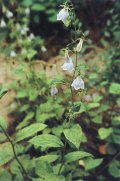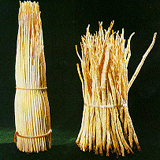Sha Shen
http://www.100md.com
《e Natural Health Center》
 |
 |
 |
Yin Tonics
Sha Shen
Latin:
Radix Adenophorae Strictae
Origin:
This herb is divided into adenophora root "Radix Adenophorae," or "nan sha shen"; and glehnia root "Radix Glehniae," or "bei sha shen."
Adenophora root is the dry root of the perennial herbaceous plant Adenophora triphylla (Thunb.) A.DC., or Adenophora tetraphylla ((Thunb.) Fisch. ex B.D.Jacks.), of genus Ladybell of the family Campanulaceae. Native to east Asia, this plant is grown on grassy places in lowland and mountains in China, Korea and Japan.
, http://www.100md.com
Adenophora grows to about 1 m high. It is in flower in September, and the seeds ripen in October. The flowers are hermaphrodite (have both male and female organs) and are pollinated by insects. The plant cannot grow in the shade. It requires moist soil.
Adenophora grows in mountains and fields throughout China, but mainly in Anhui, Jiangsu, Sichuan and other provinces. The root is dug out in spring and autumn, cleared of cortex, dried in the sun and used unprepared.
, 百拇医药
Glehnia root is the dry root of the perennial herbaceous plant Glehnia littoralis Fr. Schmidt ex Miq. of the family Umbelliferae. Native to east Asia, the plant is grown on sandy banks by the sea in China, Japan and naturalized in North America.
Glehnia grows to about 0.3 m high. The flowers are hermaphrodite (have both male and female organs). The plant can grow in semi-shade (light woodland) or no shade. It requires moist soil.
, http://www.100md.com Glehnia is mainly cultivated in coastal areas of Shandong and Northeast China. The root is dug out in spring and autumn, scaled with boiling water, cleared of cortex, dried in the sun and used unprepared.
Adenophora root is also called Ladybell Root; and Glehnia root is also called American Silvertop Root or Corkwing Root.
Properties:
Sweet and slightly bitter in flavor, slightly cold in nature, it is related to the lung and stomach channels.
, 百拇医药
Functions:
Nourishes yin to clear heat from the lung, and tonifys the stomach to promote the production of the body fluid.
It is used in the treatment of women's diseases, chronic bronchitis with dry cough, pulmonary infections with cough and thick yellow sputum, dry throat.
Applications:
1. The herb is often used in combination with ophiopogon root, trichosanthes root, anemarrhena rhizome and other herbs for nourishing yin and clearing heat from the lung, to treat impairment of yin caused by dryness in the lung with symptoms of dry cough with little sputum, dry mouth and thirst; and with anemarrhena rhizome, fritillary bulb, ophiopogon root, biota tops, dried rehmannia root and other herbs for nourishing yin and moistening dryness, to treat hemoptysis due to consumptive disease.
, http://www.100md.com
2. To treat deficiency of the stomach-yin with symptoms of dry mouth, thirst, red tongue, little saliva and anorexia (loss of appetite), the herb is often used in combination with fragrant solomonseal rhizome, ophiopogon root, dried rehmannia rooi and other herbs for promoting the production of the body fluid to quench thirst, such as Yiwei Decoction.
Dosage and Administration:
10-15 g.
, http://www.100md.com
15-30 g. when used fresh.
Glehnia root is good at tonifying yin, while adenophora root also invigorates qi and resolves phlegm.
Cautions on Use:
It is antagonistic to veratrum root.
Reference Materials:
Toxic or Side Effects:
Modern Researches:
Adenophora root has effects of clearing phlegm, expectorating heart and is bacteriostatic, while glehnia root has effects of clearing heat and alleviating pain., http://www.100md.com